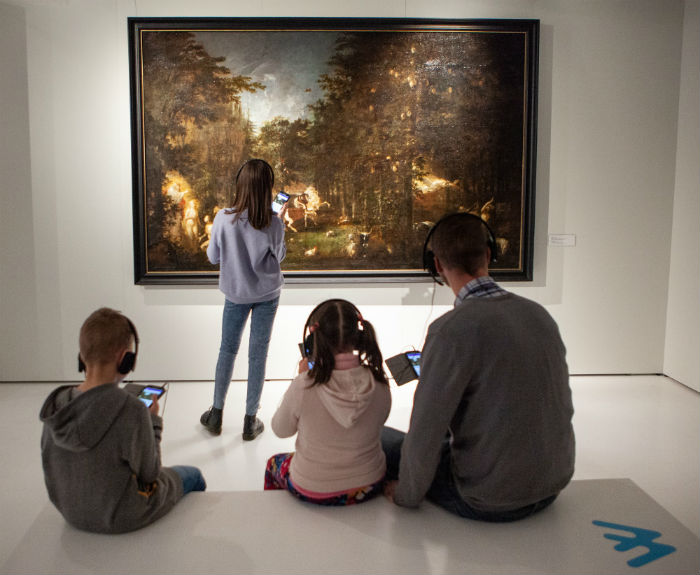AI
On the Baroque Art Trail with IBM Watson
January 27, 2020 | Written by: Jaroslaw Szymczuk
Categorized: AI
Share this post:

National Museum in Wrocław (Photo: Magdalena Wyłupek)
Art is a social and relational process. It involves interaction between the artist and the audience. It provides a dialogue, an exchange of impressions, feelings, knowledge and thoughts. This relationship can be complete, attractive, authentic and satisfactory, especially when the viewer fully understands as much as possible of the context and value of the artwork.
We want to know what’s so special about the series of Campbell soup cans in Andy Warhol’s paintings. We wonder at whom the Mona Lisa is smiling so mysteriously. We’re curious why Beethoven’s Fifth Symphony is one of the most recognizable musical motifs in the world.
Providing this kind of context is what’s behind a new AI project from IBM. Opening this week in Wroclaw, Poland, is the CoArt project that pairs mobile computing and AI with art history. Visitors to the exhibit, “Willmann. Opus Magnum,” at the Contemporary Art Museum are able to pull up a mobile app when viewing a piece of the exhibit, ask questions about the piece and receive immediate answers. The museum, which is a branch of the National Museum, used IBM’s Watson Assistant for the solution. Watson Assistant leverages natural language processing that understands human language and is able to provide quick, accurate responses.
To make that happen, the museum fed troves of art history data into the platform, including information about the artist, the story and the context in which the work was created, famous interpretations, and more.
The perspective of artificial intelligence becomes fascinating when viewed in the context of modern art – a genre which is often difficult to explain and therefore detached from popular culture. Who among us has not asked questions about works of modern art, like: What is it? What does it mean? How was this work created? Would I be able to do that too? Why is it a work of art at all? There may be as many good answers to these questions as there are viewers asking them, each with individual cultural and cognitive capital.
These add to the preexisting barriers to participation in art, which include things like lack of time, money, distance from cultural institutions, education, material situation, lack of companionship, etc. Research indicates[1] that the catalogue of barriers is large and that their effective abolition must be related to their correlated clusters and not to individual actions.
Sometimes people don’t go to an exhibition, a show or a concert, because they are ashamed of their lack of knowledge, they’re afraid it’s not for them or think that they just won’t fit in. Professionalized cultural institutions usually have a significant amount of data about the audience – their habits, participation practices, preferences, needs, preferred communication styles.
There is so much of this data that one of the biggest challenges of audience engagement is to process it sensibly, to extract the key and the relevant conclusions from that knowledge. In this context, AI can be a very useful tool to understand the real needs and conditions for the audience participation. In addition, AI can play a critical role in the processing of large amounts of data enabling, for example, program profiling, marketing activities, ticketing, customization of reception, and even the individual requirements of viewers.
In 2018, 56% of Poles over 15 years of age declared that they participated in a cultural event at least once a year[2], however sports events were included in the survey. On the other hand, during the 12 months 79% of the respondents have not been to the theatre, 75% to a museum or gallery and 65% at a concert.
Whether we consider this data optimistic or pessimistic, one thing is certain – together we have many opportunities for fascinating cooperation. We are ready. And we invite you.
The Willmann. Opus Magnum runs through April 26, 2020.
[1] http://www.kulturalna.warszawa.pl/tmp/relacja_i_roznice.pdf
[2] http://www.tnsglobal.pl/archiwumraportow/files/2019/06/K.027_Kultura_O003-19.pdf

Country General Manager, IBM Poland and Baltics
Making the workplace safe for employees living with HIV
The recent promising news about Covid-19 vaccines is in sharp contrast to the absence of a vaccine for HIV, despite decades of research. Unlike Covid-19 with a single viral isolate that shows minimal diversity, HIV circulates in a wide range of strains that so far have proven impervious to a single vaccine. Fortunately, more people […]
Call for Code for Racial Justice Needs You: Join the Movement
IBM has never avoided taking on big challenges. At IBM, we are privileged to drive impact at scale. We take on challenges that transform our clients, impact people’s lives and innovate for future generations as we strive to effect systematic societal change. Over the course of our 109-year history, the evidence has become clear that […]
A New Wave: Transforming Our Understanding of Ocean Health
Humans have been plying the seas throughout history. But it wasn’t until the late 19th century that we began to truly study the ocean itself. An expedition in 1872 to 1876, by the Challenger, a converted Royal Navy gunship, traveled nearly 70,000 nautical miles and catalogued over 4,000 previously unknown species, building the foundations for modern […]


